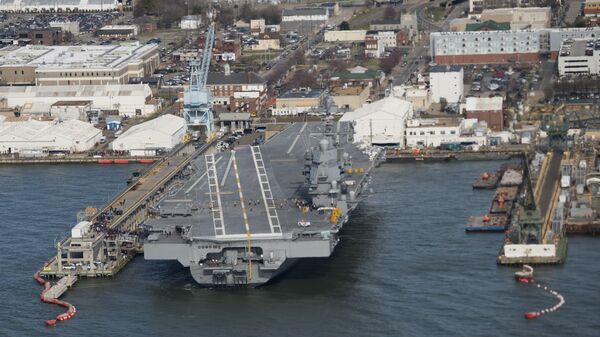“After more than 12 months of maintenance and repairs, the Navy accepted re-delivery of the propulsion plant upon PPCD [propulsion plant completion date], marking significant progress in Ford’s post-shakedown availability (PSA), and driving the ship closer to getting back out to sea,” a Monday statement by the Navy reads.
“For the past year or so, the focus has been supporting the shipyard in propulsion plant production work,” Ford’s reactor officer, Cmdr. Emily Bassett, said in the statement. “With hard work, innovation, and teamwork, reactor department Sailors and their shipyard counterparts together have achieved a major milestone. We now enter the transition phase, where our focus shifts from a shipyard production work mindset to a ship’s force operational and maintenance mindset. Reactor Department Sailors are owning it!”
The 100,000-ton warship is the largest and most expensive the Navy’s ever made, with its $13 billion budget being at least 20% over its initially projected costs. It’s powered by two uranium-fueled A1B nuclear reactors, built for the vessel by Bechtel Corporation. The reactors are estimated by the World Nuclear Association to be 25% more powerful than those used in the Ford’s predecessor class, based on the USS Chester W. Nimitz, which entered service in 1972.
According to the statement, it took 400,000 man hours of maintenance and production work to fix the ship’s propulsion train, a problem created by a “manufacturing defect” and not the seamen operating the vessel, according to shipbuilder Huntington Ingalls, which assembled the vessel in Hampton Roads, Virginia.
The Navy Times reported in May 2018, when the problems first began, that issues “reside in the mechanical components associated in turning steam created by the nuclear plant into spinning screws that power the ship through the water.” The ship returned to port in June, and evaluations began.
By March 2019, US Navy Assistant Secretary for Research, Development and Acquisition James Geurts was forced to admit to the House Seapower and Projection Forces Subcommittee that the Ford’s launch would be delayed until at least October 2019.
Engines aren’t all that’s keeping the Ford out of service, though. With only two of its 11 weapons elevators working, the ship “can’t deploy,” as Rep. Elaine Luria (D-VA), in whose district the ship is being built, put it.
The devices lift munitions from storage deep inside the carrier up to the flight deck, where they can be fastened to one of the air wing’s 75 aircraft to be deployed against foes.
Navy Secretary Richard V. Spencer reportedly promised US President Donald Trump the ship would deploy by the end of July, but with that self-imposed deadline having come and gone, it remains to be seen what consequences await the military administrator.
On a ship as loaded with new tech as the Ford, the lifts just didn’t register very high on engineers’ priorities for troubleshooting, Vice Adm. Michael Gilday told the Senate Armed Services Committee late last month. It presently appears that even when the Ford is officially delivered to the Navy in October, all its weapons lifts still won’t be working.


